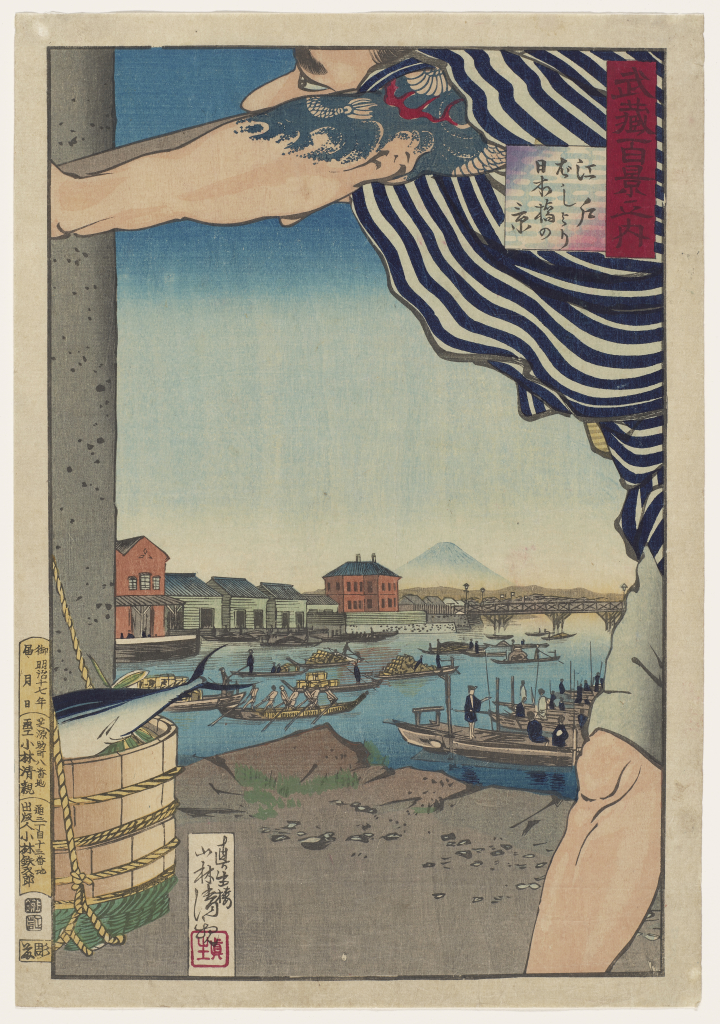Edobashi yori Nihonbashi no kei (View of Nihonbashi Bridge from Edobashi Bridge), from the series Musashi hyakkei no uchi (One Hundred Views of Musashi Province)

Kobayashi Kiyochika, Edobashi yori Nihonbashi no kei (View of Nihonbashi Bridge from Edobashi Bridge), from the series Musashi hyakkei no uchi (One Hundred Views of Musashi Province), 1884, color woodblock print on paper; ōban nishiki-e, Museum Purchase: Margery Hoffman Smith Fund, public domain, 91.5.1
This work is not currently on view.
- Title
Edobashi yori Nihonbashi no kei (View of Nihonbashi Bridge from Edobashi Bridge), from the series Musashi hyakkei no uchi (One Hundred Views of Musashi Province)
- Related Titles
original language: 江ばしより日本橋の景
series (original language): 武蔵百景之内
series (translated): One Hundred Views of Musashi Province
series (translated): One Hundred Views of Musashi Province
series (transliterated): Musashi hyakkei no uchi
translated: View of Nihon Bridge from Edo Bridge
transliterated: Edobashi yori Nihonbashi no kei
- Artist
- Related People
publisher: Maruya Tetsujirō (Japanese, active ca. 1849-1897)
- Date
1884
- Period
Japan: Meiji period (1868-1912)
- Medium
color woodblock print on paper; ōban nishiki-e
- Dimensions (H x W x D)
image: 12 3/4 in x 8 3/8 in; sheet: 13 9/16 in x 9 3/8 in
- Inscriptions & Markings
title: 江ばしより日本橋の景, printed in black ink within square cartouche, upper left Transliteration (Translation): Edo bashi yori Nihon bashi no kei (View of Nihonbashi bridge from Edobashi bridge) Language: Japanese
series title: 武蔵百景之内, printed in black ink within rectangular cartouche, upper left Transliteration (Translation): Musashi hyakkei no uchi (One hundred views of Musashi province) Language: Japanese
censor's mark: 証 [stylized], printed in black relief within square cartouche, left margin, bottom Transliteration (Translation): akashi (proof) Language: Japanese
maker's mark: 画工 // 小林清親 // 芝源助町八番地, printed in black ink within rectangular cartouche, left margin, bottom Transliteration (Translation): Gakō // Kobayashi Kiyochika // shigensukechō hachi banchi (Artist // Kobayashi Kiyochia // Shigensuke street lot number 8) Language: Japanese Description: The full name and address of the print designer, publisher, and date of publication required on woodblock prints from 1875.
publisher's mark: 出版人 // 小林鉄次郎 // 通三丁目十三番地, printed in black ink within square cartouche, left margin, bottom Transliteration (Translation): shuppanjin // Kobayashi Tetsujirō // dōri san chōme jūsan banchi (Publisher // Kobayashi Testujirō // dōri 3 chōme 13 banchi) Language: Japanese
date: 御届 // 明治十七年月日, printed in black ink within rectangular cartouche, left margin, center Transliteration (Translation): Otodoke // Meiji jūnananen gatsu nichi (registration // Meiji 17 [1884] month day) Language: Japanese Description: Month and day of publication not printed.
censor's mark: 組合 [stylized], printed in black intaglio within square cartouche, left margin, bottom Transliteration (Translation): kumiai (association) Language: Japanese
carver's mark: 彫藤, printed in black ink within rectangular cartouche, left margin, bottom Transliteration (Translation): hori Fuji (carver Fuji) Language: Japanese
artist's seal: 眞生, printed in red relief within square cartouche, bottom left Transliteration: Shinsei Language: Japanese
signature: 真生楼小林清親, printed in black ink within rectangular cartouche, bottom left Transliteration: Shinseirō Kobayashi Kiyochika Language: Japanese
- Collection Area
Asian Art; Graphic Arts
- Category
Prints
Japanese Traditional Prints
- Object Type
relief print
- Culture
Japanese
- Credit Line
Museum Purchase: Margery Hoffman Smith Fund
- Accession Number
91.5.1
- Copyright
public domain
- Terms
- Exhibitions
1999 Three Centuries of Japanese Prints from the Museum's Collections Portland Art Museum
2011 The Artist's Touch, The Craftsman's Hand: Three Centuries of Japanese Prints from the Portland Art Museum Portland Art Museum
2022; 2023 Human Nature: 150 Years of Japanese Landscape Prints Portland Art Museum









